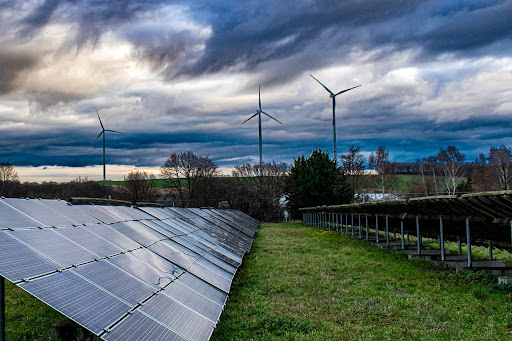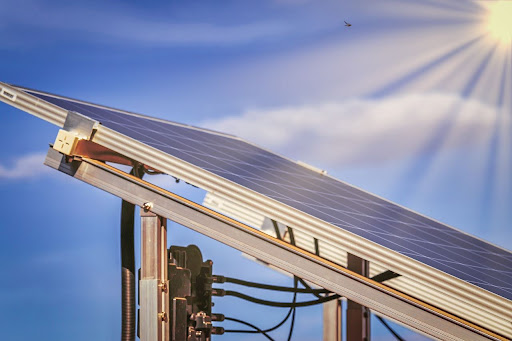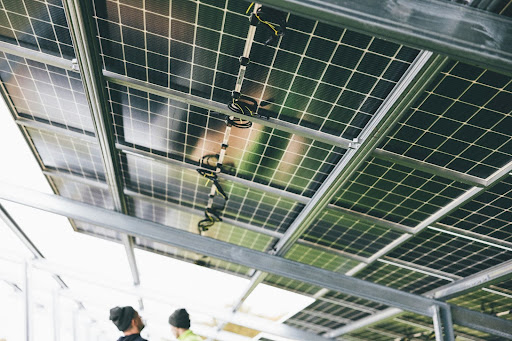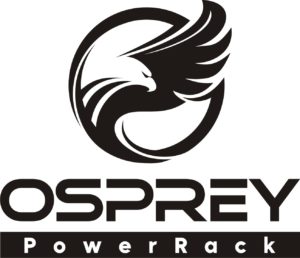Ground Mount Solar Panels In High-Wind Areas: Pros & Cons
Key Takeaways
- Ground-mount solar panels offer better stability in high-wind areas due to their secure anchoring systems.
- Installation in windy regions requires careful site assessment and robust design features to minimize damage.
- Solar efficiency can be affected by wind speeds, but ground mounts allow for optimal sun exposure.
- High installation costs are offset by long-term energy savings and environmental benefits.
- Nuance Energy’s earth anchor technology is engineered to withstand winds up to 185 mph.
Ground-Mount Solar Panels in High-Wind Areas
Initial Considerations for Installation
For regions prone to high winds, ground-mount solar panels are a viable solution, however, a thorough site assessment is necessary. This involves evaluating the soil type, wind patterns, and landscape features. The goal is to ensure the panels have a secure foundation that can withstand gusts without compromising their alignment or efficiency.
When choosing a racking system for your property, opt for models specifically engineered for high wind resistance – these often include reinforced frames and deeper anchoring solutions. Additionally, ensure that the installation complies with local building codes and regulations.
Impact of Wind on Solar Efficiency
Wind can have a dual effect on solar panel efficiency. On one hand, it helps cool the panels, potentially improving performance by preventing overheating. On the other hand, excessive wind can cause vibrations or even physical damage if the panels aren’t properly secured.
For instance, a well-designed ground mount system will incorporate wind deflectors or barriers to reduce direct wind impact. This ensures that the panels remain stable and aligned, maintaining optimal energy output. Moreover, monitoring systems can be installed to track performance and alert you to any issues caused by wind exposure.
| Nuance Energy is your superior solution for Ground Mount solar. Our patented foundation technology Osprey PowerRACK® allows for rapid installation using only handheld tools, significantly reducing both time and costs compared to traditional racking systems. This cutting-edge technology works for residential and commercial installations, and Nuance Energy empowers solar installers to take back control of their installation schedules, control project COGS, gain market share, increase the speed of installation, and reduce the cost of labor. In contrast, a traditional ground mount is much more unpredictable, slower, and costly.
Find out how Nuance Energy can accelerate your solar projects with the Osprey PowerRACK® line, and boost your profitability. Contact us today to discuss our innovative ground-mount solutions. |
Advantages of Ground-Mount Systems in Windy Regions

Ground-mount solar panels are a durable, adaptable, and reliable option for high-wind areas.
Structural Stability and Design Features
The strength of ground-mount systems lies in their robust construction. Typically, these panels are supported by steel or aluminum frames, which are driven deep into the ground. This provides a firm anchor that resists wind-induced movement.
Design features such as adjustable tilt angles and wind-resistant frames further enhance their stability. These elements allow the panels to be oriented optimally for sunlight exposure, while also minimizing the surface area exposed to wind.
Optimal Sun Exposure and Energy Output

Ground-mount systems receive better exposure to sunlight and offer superior energy production.
Besides their structural benefits, ground-mount systems offer superior sun exposure. Because they are not limited by roof angles or obstructions, they can be placed in the most sunlit areas of a property. This flexibility ensures that the panels receive maximum sunlight throughout the day, boosting energy production.
Flexibility in Panel Orientation and Placement
Ground-mount solar panels provide the freedom to adjust panel orientation and placement to suit specific site conditions. This adaptability is particularly beneficial in high-wind areas, where strategic positioning can mitigate wind impact while optimizing sun exposure.
- Customizable Tilt: Adjust panel angles to reduce wind resistance and enhance sunlight capture.
- Site-Specific Design: Tailor the installation to the topography and wind patterns of the area.
- Scalability: Easily expand the system as energy needs grow or technology advances.
Challenges and Risks in High-Wind Areas
Potential Damage from Wind Gusts
High winds can exert substantial force on solar panels, causing them to vibrate or, in extreme cases, become dislodged from their mounts. This poses a safety hazard and can lead to costly repairs and downtime.
To combat this, it’s important to choose mounting systems specifically designed for high-wind resistance. Reinforced frames, deeper anchoring, and wind deflectors are some of the features that can help prevent wind-related damage.
High Installation and Maintenance Costs
Installing solar panels in high-wind areas often involves higher upfront costs – the need for specialized mounting systems and additional engineering work to ensure stability increases the initial investment. Ongoing maintenance costs will also be higher due to the need for frequent inspections and potential repairs caused by wind exposure.
However, these costs can be offset by the long-term benefits of solar energy, such as reduced electricity bills and environmental savings. By carefully planning and budgeting for these expenses, homeowners and businesses can still achieve a favorable return on investment.
Alternatives like Nuance Energy’s Osprey PowerRACK® present a more practical choice for high-wind areas because they avoid the need for concrete or heavy equipment, helping to keep installation costs down. These products also use earth anchor technology and are built to handle tough conditions, reducing the need for ongoing maintenance.
Landscape and Environmental Constraints
The local landscape and environmental conditions can also pose challenges for ground-mount solar installations in windy areas. Uneven terrain, soil composition, and vegetation can all impact the stability and efficiency of the solar array. Additionally, local wildlife and ecological considerations must be taken into account to minimize any negative environmental impact.
Working with experienced solar professionals who understand these constraints is essential for a successful installation – they can provide valuable insights and solutions to overcome these challenges, ensuring that the solar system performs optimally while respecting the surrounding environment.
Strategies for Mitigating Wind Damage

Conducting regular inspections to identify and address any issues promptly significantly reduces the risk of wind-related damage.
Investing in Robust Mounting Mechanisms
One of the most effective ways to prevent wind damage is by investing in robust mounting mechanisms. These systems are designed to withstand high wind pressures, providing a stable and secure foundation for the solar panels. Look for features such as adjustable tilt angles, reinforced frames, and durable materials that can endure harsh weather conditions.
Incorporating Wind Barriers and Shelters
Another strategy is to incorporate wind barriers or shelters into the solar installation. These structures can help deflect wind away from the panels, reducing the force exerted on them. Wind barriers can be natural, such as strategically planted trees or shrubs, or artificial, like specially designed windbreaks or fences.
Regular Maintenance and Inspection Routines
Schedule routine checks to identify any signs of wear or damage and address them promptly. This proactive approach helps maintain the system’s integrity and prevents minor issues from escalating into major problems.
Why Choose Nuance Energy’s Osprey PowerRACK® for High-Wind Areas?
- Fast Installation: The Osprey PowerRACK® can be installed quickly, reducing exposure to unpredictable high wind conditions during construction.
- No Concrete Required: Our patented earth anchor foundation eliminates the need for concrete, making it easier to install in high-wind areas without delays.
- Wind-Resistant Design: Engineered to withstand wind speeds up to 185 mph, the system offers reliable performance in extreme weather conditions.
- Durable and Low-Maintenance: With anti-corrosive materials and a sturdy design, our system requires minimal maintenance even in harsh, windy environments.
- Adaptable to Terrain: The earth anchor technology adjusts to various soil types, ensuring a stable installation on wind-exposed terrains.
- Reduced Installation Costs: By avoiding heavy machinery and complex setups, the system keeps installation costs low, especially in remote, wind-prone locations.
- Long-Term Stability: The real-time pull testing during installation ensures a secure foundation, reducing the risk of wind damage over the lifetime of the system.
Ready to take the first step?
Contact us to learn more about our products or get a quote on your next project.
Frequently Asked Questions (FAQ)
How do wind speeds affect solar panel efficiency?
Wind speeds can influence solar panel efficiency in two main ways. On the positive side, wind can cool the panels, which may improve their performance by preventing overheating. However, excessive wind can cause vibrations or damage if the panels aren’t securely mounted.
What type of foundation is best for ground-mount systems in windy areas?
In high-wind areas, the best foundation for ground-mount systems is one that offers deep anchoring and reinforced stability. Systems with steel or aluminum frames driven deep into the ground provide a strong base that resists wind forces. Additionally, adjustable tilt angles and wind-resistant frames can enhance the system’s resilience and ensure optimal performance.
Can ground-mount systems withstand hurricane-force winds?
While ground-mount systems are designed to withstand strong winds, hurricane-force winds pose a significant challenge. To increase the chances of withstanding such extreme conditions, it’s essential to invest in systems specifically engineered for high wind resistance. This includes reinforced frames, deeper anchoring, and strategic placement to minimize wind exposure.
Are there better solar racking alternatives for windy areas?
Nuance Energy’s Osprey PowerRACK® is a good alternative to traditional ground mounts due to its wind-resistant earth anchor foundation, which can withstand speeds up to 185 mph. Its quick, concrete-free installation reduces costs and ensures long-term stability with minimal maintenance.
Save Time & Money on Your Next Solar Project
Request a QuoteRECENT POSTS
- DPW Solar vs Nuance Energy Mounted Solar Options: Cost & Benefits
- Geotechnical Report Cost & Requirements For Solar Projects
- Are Solar Panels Worth It In Nevada? Costs & Options
- OSPREY PowerRack Ground Mount System Compatibility: Single- and Dual-Axis Trackers
- Rammed Earth Foundation For Solar Arrays: Cost, Pros & Cons
- Agrivoltaics Explained: Solar & Agriculture Combined
- Large Scale Solar Systems Options: Pros & Cons
- Best Solar Options For Farms & Agriculture: Cost, Pros & Cons
- Unirac vs MT Solar Mounted Options: Cost & Benefits
- IronRidge vs Grengy Mounted Solar Options: Cost & Benefits

